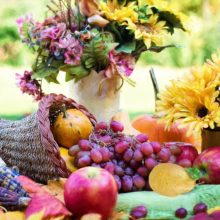Thanksgiving is a time to show our appreciation for what we have in life, to turn our attention toward what truly matters. As we look at life through the lenses of gratitude, we remove the blinders and can see the world and the people in our lives as blessings and gifts. We can view the world the same as we have in the past or with childlike wonder and inspired awe. It’s a choice.
Practicing gratitude and filling the heart with appreciation helps to lower stress by encouraging and cultivating elevated, heartfelt emotions. Anger, resentment, and sadness cannot co-exist when we are genuinely feeling thankful, grateful, and happy. Joy filled feelings help lower the production of stress hormones like cortisol. Gratitude increases the release of oxytocin, known as the love hormone, which helps reduce cortisol and blood pressure and creates a calming effect. It helps alleviate mild depression and build resilience. Therefore, be grateful is an ideal way to reduce stress and anxiety and improve our mental, emotional, and physical health and wellbeing.
Alongside gratitude is giving thanks. Thanking those people that make our lives fuller and more meaningful, and who we never want to take for granted. We want to thank the people we meet throughout our day. Also, it feels warm and fuzzy inside to thank people we may not know and who did something nice for us at that moment. Perhaps someone who holds a door open for you or lets you pass through first — thanking the person who was helpful or showed kindness to you in some way. As you say, I thank you, or I appreciate you, remember to smile and invite the face and eyes say thank you too. You can also express your appreciation and gratitude by mailing the recipient a handwritten thank you card.
Being thankful when things are not running as planned is a practice that may take time to master. Be patient with yourself. Start with easier situations. Consider giving thanks for the opportunity to wait in line or be stuck in traffic. It can be a reminder to slow down and be present to what is happening at that moment. Use that time to relax and breathe and appreciate the scenery and surroundings. What do you see and hear? What are your thoughts and feelings? Observe what’s going on around you in your world, your reality.
As gratitude fills our awareness and softens the heart, we may notice how much more we are grateful for than we could have ever imagined. When we connect with others with gratitude, there is an energy exchange, and we can feel a sense of resonance and kinship with them. Gratitude and appreciation are about loving self and others and the world in which we live.
Gratitude is a marvelous practice to begin and end a day. Ever since my near-death experience twenty-five years ago, the first words I utter even before I open the eyes is thank you. I give thanks for another day to enjoy this beautiful world in which to grow in mind, body, and spirit.
As I close the eyes at night to sleep, I recall what brings me joy and express what I’m grateful for in my life. Focusing on the positive aspects of our day can help us let go of any worries or concerns, and help improve our quality of sleep.
Gratitude exercise
For one day, be grateful for everything that enters your life. Include the positive interactions along with the challenges. We give thanks for everything we attract into our lives, for it is a learning experience and serves a purpose. Life’s little ups and downs can be a blessing too. They have the potential to help open our awareness, understanding, and acceptance. So, welcome and bless the magical moments – the challenges, the pleasures and the unpleasant, the sweet and the bitter. Be aware of how you feel before and after embracing, practicing, and expressing gratitude.
After a day of gratitude, extend this exercise to where you are expressing daily gratitude for everything and everyone in your life. Being grateful and giving thanks is transformative. Be open to a bigger picture and appreciate all aspects of life and the mystery of life itself.
Note: The information contained in this article is for educational purposes and is not intended to be a substitute for professional medical advice, diagnosis, or treatment. Consult with your doctor first before starting any new practices or health programs.
Copywriter Notice: No part of this article may be used without the written permission of Jan Kinder.



Leave a Reply